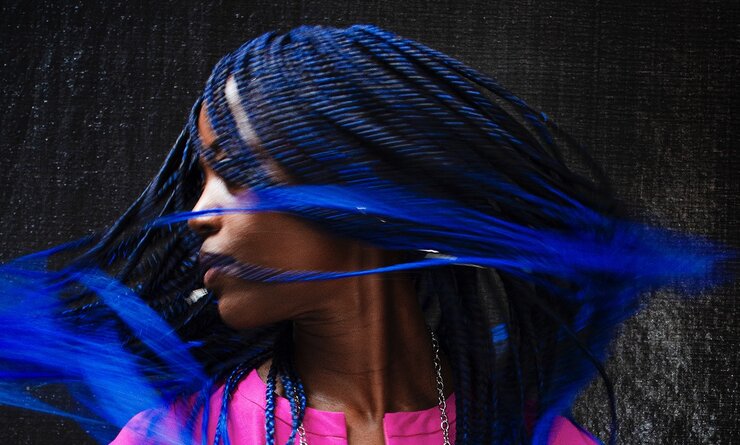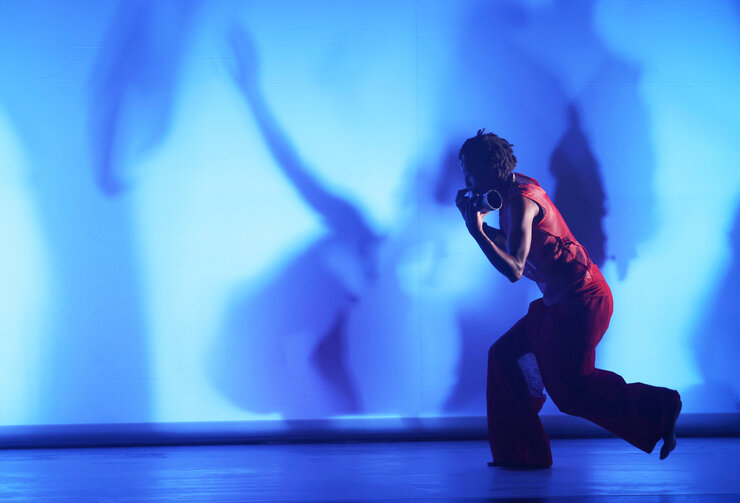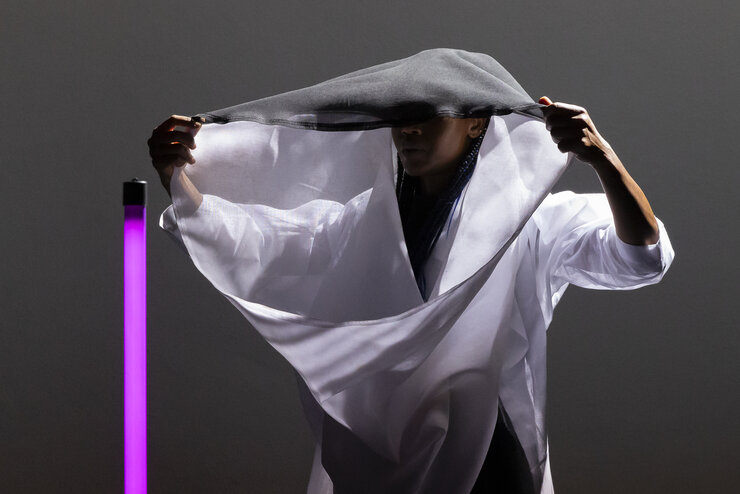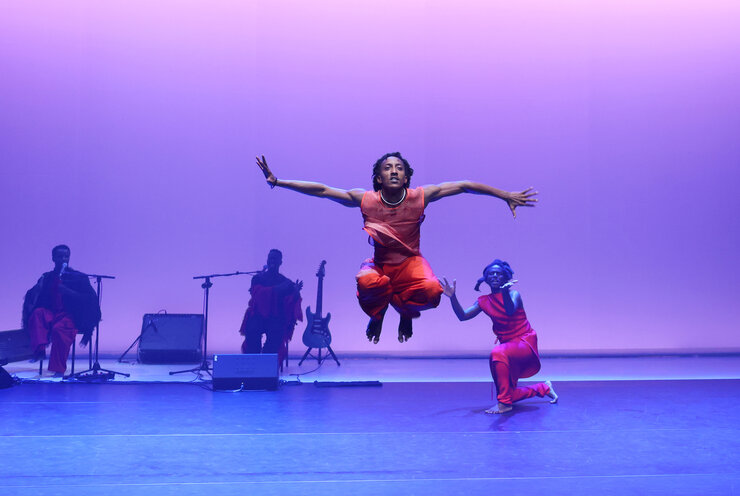
«Because history is not only in the past, but also written day by day by people and especially by the youth.»
Dorothée Munyaneza, as a multi-disciplinary artist, dedicates her work to memory, aiming to make erased or lost voices, stories, and bodies visible and audible. Starting from the here and now, she creates spaces where the past and future come alive in woven simultaneity, full of joy in the encounter between traditional knowledge and contemporary embodiment.
The Rwandan choreographer, musician, singer, and performer moved to England with her parents as a child and is now based in France, where she founded her company «Kadidi» in 2013. Music, song, text, and movement are the primary mediums in Munyaneza’s work, in which she sometimes performs herself. Her pieces tour worldwide, and she plays a significant role in shaping the French dance and theatre scene, particularly in Marseille and Paris. In 2021, Dorothée Munyaneza was a guest at the Theater Spektakel with the piece «Mailles». This year, two of her works, «Toi, Moi, Tituba» and «umuko», are being presented in Zurich, offering a deeper insight into the work of this versatile artist.
Your piece «umuko» is full of unbridled joy and beauty. What does «umuko» stand for?
Umuko is a type of tree indigenous to Rwanda. It has been a part of Rwandan culture and mythology for centuries. Its bright, vibrant red flowers stand out. The landscape of Rwanda is lush for most of the year, with all kinds of hues of green. And then, amidst this greenery, you have these bright red flowers. When I was a child growing up in Rwanda, I was drawn to it. So, I asked my elders, particularly my grandmothers, what this tree was. They explained to me that it used to be very significant in our culture and religious practices, and that its flowers have healing properties. It is truly a beautiful tree.
When Rwanda was colonised – first as a German protectorate, and later under Belgian rule – the culture surrounding this tree, the myths, and the symbolism it represented were erased. We were violently and forcefully converted to Christianity. Anything this tree symbolised in our ancestral societies was pushed aside or even forbidden. However, the tree itself physically remained, and it still exists today. For me, «umuko» stands for these kinds of questions: What were we? What kind of history did we carry? What kind of narratives did we have in pre-colonial times? And what does this tree symbolise today, when its original meaning has either been forgotten or, at times, transmitted from generation to generation, but in secret?
For «umuko», you travelled to Kigali to work with young artists who are active there.
Whenever I went to Rwanda, I thought about how to reconnect with the past, with history, but also with its ongoing history, its young people. Because history is not only in the past; it is also written day by day by people, especially by the youth. So, I was looking for their narratives, their purpose. What do they aspire to? What do they want? What is their power? I wanted to go to the roots of this Umuko tree, but also speak about its branches and flowers, which are these young people who are articulating the culture of Rwanda today.
I’m interested in how young people today tell the stories of their lives. In «umuko», I’m not just talking about people; I’m talking about the living, about how even memory is alive. If we keep talking about cultures or people, we keep their memory alive. These young artists, for me, are giving life to and embodying something that will inspire the audience’s way of seeing the world, or even of seeing Rwandans. Often, when we talk about my country, the first thing that comes to mind is the genocide against the Tutsi in 1994. Of course, this is a very central point in our history and in the way we live today. However, I also want people to remember that we had a history before that, before we were colonised, before we were converted to Christianity. It’s about who we are today, and who we were yesterday, before we were wounded.

The five artists we see on stage in «umuko», what practices do they have and what attracted you to them?
Collaborating with them was about sharing knowledge, history, stories, and artistic practices. They are musicians, dancers, composers, instrumentalists, vocalists, filmmakers, fashion designers, and one is also a music producer. This multiplicity of talents and their transdisciplinary approach greatly attracts me, and I wanted to bring this into the work. It’s a group of people who are truly important and vital in the artistic field in Rwanda right now. And all of them are, on the one hand, connected to ancestral knowledge, but also very much connected to the future.
During the creative process, one word stood out to me and captured this: «ejo». In Kinyarwanda, it means both «yesterday» and «tomorrow». I wanted to connect the past and the future through this young generation of artists, using the present as a space to connect these two chronologies. This work is really about celebrating their craft, their artistry, their stories, and celebrating their beauty as well.
They know many things that I don’t – some very old poems, songs, and stories passed down from their ancestors. And so, I wanted to receive from them too; it’s not just about me giving them something. They’re giving me, feeding me, teaching me. I’m growing with them, and at the same time, I also see the impact that the work I envision has on their own practices. So, it’s about intertwining these stories and roots in order to truly bloom together. There’s a lot of hope in this work.
You talked about memory and history being alive in today’s bodies and minds, and also how it can be brought to life again. I would say this is a theme that connects «umuko» to another one of your works we will be seeing in Zurich, «Toi, Moi, Tituba», a solo performance with you as the performer.
For this work, I used two references. One is Maryse Condé’s book «I, Tituba, Black Witch of Salem», a fictional work she wrote after seeing the phrase «Tituba, Black Witch of Salem» in an archive, specifically in the trial minutes of the Salem witch trials, where Tituba was judged. Starting from that one phrase, Maryse Condé created an entire biography. Imagining what Tituba could have been, she literally brings her to life. She gives her a body, a heart, love, and all kinds of healing powers.
The other very important reference is «Me, You, Us: I, Tituba and the Ontology of the Trace» by philosopher Elsa Dorlin. She uses Maryse Condé’s fiction to discuss the lives of those made invisible, erased from, let’s say, administrative Western archives, with a particular focus on the African slave trade to the Americas. Interested in this erasure, she returns to these same archives to find her people, her lineage – Elsa Dorlin’s ancestry is in French Guiana – and eventually discovers her great-grandmother Isabelle. This entire philosophical text is written as a homage to her ancestor and to reconnect with those made invisible. There’s a beautiful line in her text that says: «To become Tituba, to care for the lives that lie in the archives.»
For me, «Toi, Moi, Tituba» is a tribute not only to Tituba, as an existing figure, but to all those other figures, particularly women, who might exist only as traces in archives – just a name or a number – or who have been completely erased from history. Because, often, history is written by men, mostly by white European men.
So, going back to my work: How can I, as an artist of African descent based in Europe, who has created roots on different continents, also speak about those who are forgotten? The memories of them that I carry, particularly through my ancestry, my grandmothers – who were also healers in their time – are implicit, intimate to my own story. But I’m also actively paying homage to their memory by becoming, or returning to, Tituba. I look for ways to activate the archive using music, choreography, sound, and my voice, bringing together the various worlds – the visible and the invisible. Asking: How can art, how can performance, become that space of remembrance?

Another element that links both «umuko» and «Toi, Moi, Tituba» is music. You started your career as a musician?
I did. I studied music and singing in England, as well as social sciences. Music has always played a central role in my work.
When does music enter the process? Is there a musical composition first, from which you develop the piece? Or is it more of an organic process?
For me, it’s really an organic process, where I can’t separate one from the other. When collaborating with musicians, such as Khyam Allami in «Toi, Moi, Tituba» or the musicians and dancers from «umuko», music and dance always develop simultaneously.
How does the body vibrate to the frequencies of music? If the body is moving, what kind of music does it create? What kind of voice, what kind of cry emerges from this body? What kind of laugh? Choreography, for me, is rhythm, vibration, and resonance. So, music and dance are intimately intertwined.
The other aspect is: I’m interested in narratives, in stories, so words are very important to me. And words also have rhythm; languages have rhythm. I’m interested in these multiple layers that music, choreography, words, poems, and images can create, in order to expand our understanding and reception of the work.

You recently toured with «umuko». How was it to travel with this work?
It’s always good to be able to tour, especially nowadays when there are a lot of budget cuts, restrictions, and fragility for companies. In particular, with «umuko», the opportunity to bring artists from Rwanda and tour with them is especially significant for me. I don’t take it lightly at a time when so many walls are being built everywhere, so many wars are happening, and there is so much racism, xenophobia, homophobia, Islamophobia, and anti-Semitism. There’s so much violence in this world. As artists, we can contribute by building bridges, by creating spaces of collaboration and intimate encounters, poetic spaces where we can feel seen, heard, and celebrated.
We began our tour of «umuko» in February, traveling to France, Belgium, and Germany… However, we faced some visa issues. Three of the artists had their visas denied, so we had to reapply. While waiting for the visas to be approved, I found myself thinking… or even telling some of the people at the venues where we were meant to perform: If we are ultimately denied these visas, it wouldn’t just be a loss for our company, unable to come to these European countries and perform. It would also be a loss for the audiences at these venues, who would miss the opportunity for this encounter and to be immersed in this world. It’s not a one-way situation. We are all in this together. As performance artists, we need spaces in which to resonate. But audiences also need to experience our work. If there are no artists on stage, these spaces hold no value. These spaces are activated by our presence.
I think it’s really important to occasionally shift the perspective on the relationship between the artist and the audience.
Yes. When you spend time only with the people you know, without encountering any alterity, you miss out on so much. There's so much we miss when we don’t engage with new perspectives. For me, that’s what it’s all about. How do we connect with other human beings, other cultures, different histories and journeys, and alternative narratives? Because that’s what expands our vision and opens our hearts. That’s what helps us truly understand that we are all connected.
Credits
Interview: Marta Piras
The interview was conducted in English
Translation into German: Franziska Henner
Portrait photo: PatCividanes_Antro Positivo
Photos from ‘umuko’: Patrick Berger
Photos from ‘Toi, moi, Tituba...’: Dajana Lothert